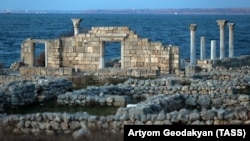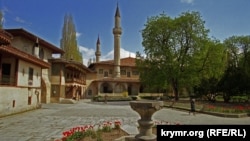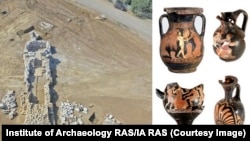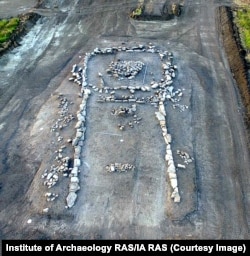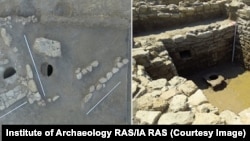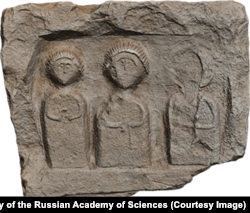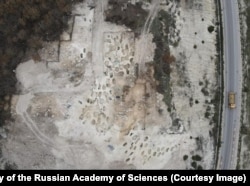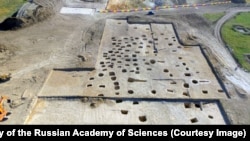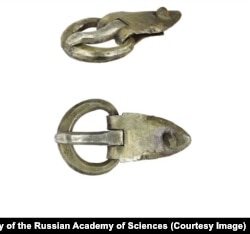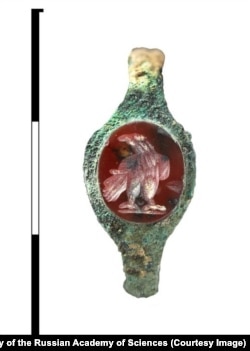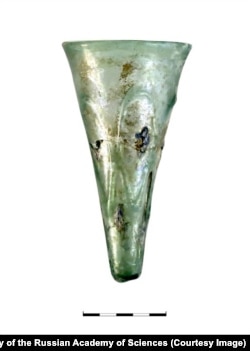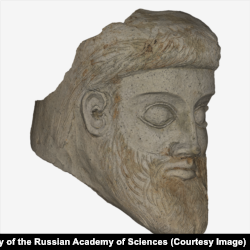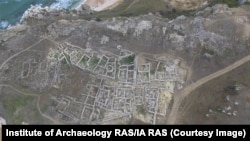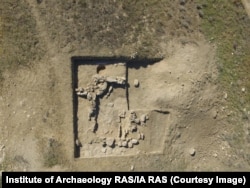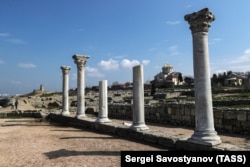Crimea's identity as a point of conflict among regional powers has been recognized since at least the 5th century BC, when Herodotus described the Scythians who lived there as barbarians who drank wine from gilded skulls, burned lots of cannabis, and feted Greeks who arrived on their territory with pomp and sacrifice.
What the Greek historian could not have foreseen is that an invader from the east would seize the Black Sea peninsula 2,400 years later, dig everything up, and claim for itself the historical legacies of all who came before.
That Gold Is Mine
Russia wasted little time staking its claim to Crimea's archaeological bounty when it seized control of the Black Sea peninsula from Ukraine in March 2014, after sending in troops and staging a referendum dismissed as illegitimate by the UN General Assembly.
By the end of the year Russia had launched a series of new archeological digs and placed the museums, cultural sites, and scientific institutions of the region – a crossroads of civilizations for many centuries -- under its administration.
"All strangers shipwrecked on their coast, and particularly every Greek who falls into their hands, they sacrifice to a virgin, in the following manner: after the ceremonies of prayer, they strike the victim on the head with a club..."Greek historian Herodotus's description of the Scythians who lived in Crimea in the fifth century BC .
In Kyiv's eyes, it's simple: these are looted treasures. Ukraine contends that the digs, sites, and institutions are being stolen by Russia, whose claim to Crimea is recognized by only a handful of countries. It says that some sites have been damaged and some discoveries taken to Russia, and fears this will continue.
Freed to excavate vast stretches of Crimea under occupation -- much of it along the path of a major bridge and peninsula-spanning highway meant to cement Moscow's connection to the territory -- Russia has unearthed new historical sites and appropriated a trove of archeological treasure.
More than 1 million artifacts alone were found during the construction of the Crimean Bridge, which crosses the narrow Kerch Strait once plied by ancient ships ferrying grain, pottery, and other goods between the Sea of Azov and the Mediterranean. And that number has continued to rise even after Russian President Vladimir Putin marked the completion of the Tavrida highway running from Kerch to the southwestern port city of Sevastopol by taking a drive in August 2020.
To date, at least 29 Russian-controlled entities have participated in illegal excavations, the Ministry For The Reintegration Of The Temporarily Occupied Territories Of Ukraine told RFE/RL, while additional digs carried out by grave robbers have also been recorded.
Any attempts to monitor the quality and conduct of the excavation -- or "looting" as described by the ministry -- of archeological sites "were blocked by the Russian occupation administration in Crimea."
Check Out, Never Leave
Archaeologists have compared Crimea to a thin-necked bottle that many peoples and cultures have entered but could never really escape.
And the list is long:
Cimmerians, Scythians, Greeks, Pontics, and Romans.
Sarmatians, Byzantines, Mongols, and Ottomans.
Goths, Huns, Khazars, Slavs, Crimean Tatars, and many more.
Since the Russian takeover, a wealth of fresh evidence of their existence in Crimea has been unearthed -- including burial mounds, settlements, and antiquities that had laid undisturbed for centuries. But a hunger for historical knowledge may not have been the catalyst for that push: a Russian law required that excavations be conducted before federally funded infrastructure projects on the peninsula could begin.
The requirement gave archaeologists "a unique opportunity to conduct large-scale research in different regions of Crimea" according to the Institute of Archeology at the Russian Academy of Sciences, and resulted in the largest excavations "in the archeological history of Crimea."
'New Building'
The "New Building Archaeological Expedition," launched in 2016, followed a 310-kilometer path of the Tavrida highway crossing the peninsula. About 100 sites, dating from 80,000 years ago to the early 20th century, were discovered along the way.
According to the Russian Institute of Archaeology, more than 10,000 discovered items were transferred to Crimean museums, which are now controlled by Moscow.
Among the more notable discoveries of the "New Building" effort are the Hospital Mound -- so named because it is located near a Kerch hospital -- which contains the remains of members of the Bosporan nobility.
There is also a Bronze Age burial mound named Kurgan Fountain 1, which features large stones assembled around a slab covering the body of a baby.
And a Golden Horde settlement known as Kosh-Kuyu, located on the far eastern reaches of the peninsula near Kerch.
Kil-Dere 1
Excavations of the Kil-Dere 1 burial ground in the Inkerman Valley near Sevastopol resulted in the discovery of 232 graves and 63 steles, or carved commemorative pillars and slabs, the largest collection of Late Scythian gravestones in Crimea.
Front-3
Excavations along the Belbek River near Sevastopol in 2018 uncovered Front-3, a Roman-era necropolis consisting of 200 graves that are still being explored and the remains of 250 people.
Among the finds are buckles, rings, pendants, and a conical goblet.
Greek Head
In 2017, divers discovered a giant Greek terracotta head in the waters of the Ak-Burun Cape, a stone's throw from the railway portion of the Crimean Bridge as it arrives at the peninsula.
Researchers are still trying to gain information about the origins of the piece, with some suggesting it might be part of a bigger statue, but one thing is known for certain: its discovery was the first of its kind in the northern Black Sea.
East Crimean Expedition
This expedition is focused on fortified settlements and estates in the peninsula's Azov region.
Excavations at one settlement, Polyanka, have uncovered Sinop amphorae with stamps from the 3rd to 2nd centuries BC.
Kara Toba
Also ongoing is the dig at Kara Toba, a settlement from the 4th century BC located in northwestern Crimea.
Work has been going on since the mid-1980s at the site, which served as a fortress for a Pontic king and later Scythians until it was destroyed by Bosporans.
Lost In Transition
The most notorious dispute over Crimean antiquities doesn't involve finds made under Moscow's watch, but instead concerns a collection of precious artifacts that were on tour abroad when the Russian occupation began.
The collection, which includes a gold scabbard and ceremonial helmet, jewelry, gems, and other finds provided on loan from four museums in Crimea and one in Kyiv, currently awaits its fate in storage in the Dutch capital.
"These objects and other archaeological discoveries reveal the rich history of the peninsula colonized by the Greeks since the seventh century BC. The Crimea and the Black Sea were and remain an important crossroads between Europe and Asia. A perfect example of this is featured in the exhibition: a lacquered box, originally from China, that in Roman times found its way to the Crimea via the Silk Road. This exhibition casts new light on the Scythians, Goths and Huns, for centuries dismissed as little more than 'barbarians.'"From promotional material announcing The Crimea -- Gold And Secrets Of The Black Sea exhibit at the Allard Pierson Museum
More than 570 artifacts from the collection are now at the center of a lengthy court triangle involving four Crimean museums, the Ukrainian state, and Amsterdam's Allard Pierson Museum (APM), which exhibited the collection from February to August 2014 and returned items borrowed from the Kyiv museum but opted to hold items borrowed from Crimea in safekeeping.
Attorney Paul Loeb, who is representing the Dutch museum, told RFE/RL "it is not up to the Allard Pierson Museum to determine or decide to whom the disputed objects should be returned."
The Crimean museums, meanwhile, maintain that the APM is "in breach of obligations" of a loan agreement worked out before Russia's seizure of Crimea, and argue that the law does not provide a basis for transferring the collection to Kyiv.
Ukraine argues that it is the rightful owner of the collection. In 2016, a Dutch court agreed, ordering the collection returned to Kyiv because the objects were part of Ukraine's heritage.
An appeal followed, resulting in an interim decision that said key considerations in the first ruling -- the UNESCO Treaty of 1970, the Dutch Heritage Act, and other legislation that deals with the transfer and ownership of cultural property -- did not apply.
Following delays caused by the coronavirus pandemic and extensions taken by the court, a final decision is expected on September 14.
Matter Of Preservation, Integrity
Kyiv says that the collection and everything Russia is now digging up -- like the peninsula itself -- must be returned to Ukraine.
The Ministry for the Reintegration of the Temporarily Occupied Territories of Ukraine said that "the rights to all cultural heritage sites of the Crimean Peninsula belong exclusively to Ukraine."
It listed a number of concerns about the ongoing archeological activities on the Crimean Peninsula.
One is that the transfer of Crimean cultural objects to Russian museums to be exhibited has led the ministry to conclude that "the illegal movement and sale of cultural heritage sites from the Crimean Peninsula is highly probable."
Another is that, with no way for Ukrainian authorities to monitor the digs, the integrity of excavation sites will be undermined and the historical and cultural value of cultural heritage sites -- such as the Bakhchisaray Historical and Cultural Reserve and the ancient city of Tauric Chersonesos, a UNESCO World Heritage site -- will be harmed.
This is particularly a problem, according to the ministry, "given the active conduct of illegal archaeological excavations by the Russian Federation, in particular in the construction of large infrastructure facilities and cases of unprofessional 'restoration work'" at certain sites, including the world's only example of Crimean Tatar palace architecture at the Bakhchisaray reserve.
In that case, brick was torn off the Khan's Palace and painting on the facade was damaged when restorers attempted to clean it.
Its concerns have led Ukraine to consider ways to involve "international observers with a UNESCO mandate to monitor the situation in the temporarily occupied territory" without de facto recognition of Russian jurisdiction in Crimea, the ministry said.
The Dig Goes On
Regardless of what Kyiv thinks or wants, the digs continue, with Russia openly recruiting volunteers to help excavate Crimean sites with support from Russia's Millennium Heritage Fund, and financing from Putin's office.
Open Archeology, a site that urges readers to "discover the past of Crimea with us," lists seven possible expeditions in 2021. But spaces are filling up fast, with one near the village of Opushka, in the Crimean foothills 15 kilometers southeast of Simferopol, already booked.




